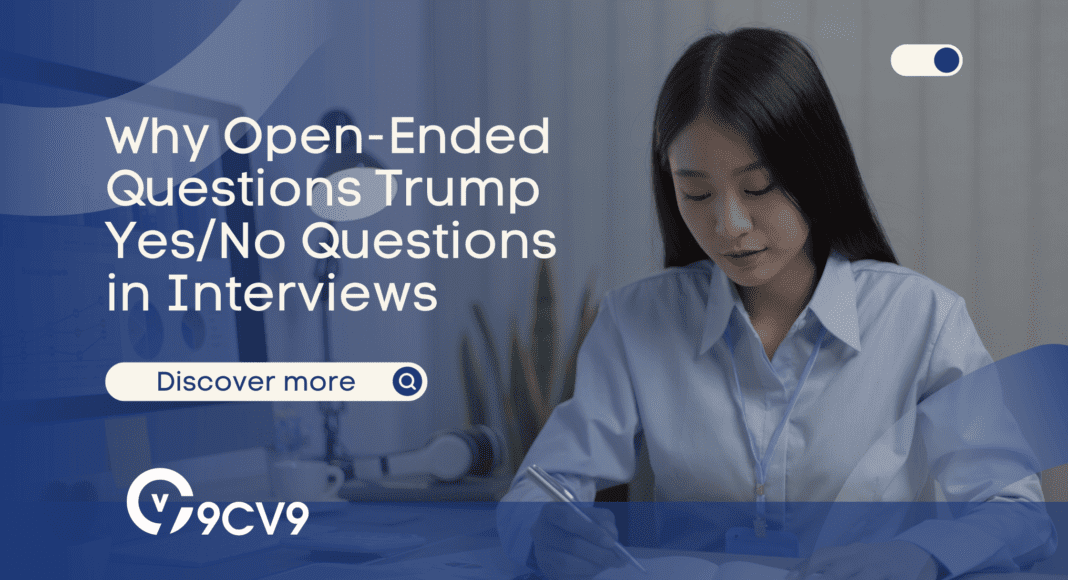Key Takeaways
- Enhanced Candidate Insights: Open-ended questions provide in-depth candidate responses, revealing skills, experiences, and problem-solving abilities.
- Fair Assessment: A balanced use of both question types ensures fairness and reduces bias in interview evaluations.
- Competitive Advantage: Mastering the art of open-ended questions empowers organizations to make informed, forward-looking hiring decisions.
In the intricate dance of hiring the right talent, interviews hold the spotlight as a pivotal stage where candidates’ true colors emerge, and employers make life-altering decisions.
It’s a make-or-break moment that can chart the course of a company’s future success or failure.
Amidst this high-stakes scenario, questions take center stage as the conductor of this symphony, shaping the narrative of each interview, guiding conversations, and ultimately determining who gets the golden ticket.

But, here’s the catch: not all questions are created equal.
In fact, there’s a substantial divide in the world of interview questions that has a profound impact on the quality of information employers glean from their candidates.
On one side, you have the succinct and straightforward Yes/No questions, and on the other, the expansive and thought-provoking Open-Ended questions.
In this digital age, where every decision can be influenced by data, we delve deep into the question of whether Open-Ended questions indeed trump Yes/No questions in interviews.
Is it just a matter of preference, or does one truly hold the key to unlocking a candidate’s full potential and fit within your organization?
Join us on this illuminating journey as we explore the dynamics of interview questions, the art of extracting genuine insights from candidates, and how your hiring process can be transformed by embracing the power of Open-Ended questions.
Whether you’re an experienced HR professional seeking to refine your interviewing techniques or a business owner searching for the brightest talent to propel your company forward, this blog will equip you with the knowledge and strategies needed to make informed decisions that will shape your organization’s future.
In the following sections, we’ll delve into the nuances of Open-Ended and Yes/No questions, dissect their strengths and limitations, and provide you with practical advice on crafting the most effective questions for your specific interview needs.
By the time you’ve journeyed through this comprehensive exploration, you’ll be armed with the tools and insights to revolutionize your interviewing process and make the best possible choices for your company’s growth.
So, let’s embark on this enlightening quest to understand why, in the realm of interviews, the open-ended question reigns supreme, and how it can be your secret weapon in the pursuit of excellence in hiring.
Buckle up; we’re about to unveil the interview techniques that can transform your hiring process from ordinary to extraordinary.
Before we venture further into this article, we like to share who we are and what we do.
About 9cv9
9cv9 is a business tech startup based in Singapore and Asia, with a strong presence all over the world.
With over eight years of startup and business experience, and being highly involved in connecting with thousands of companies and startups, the 9cv9 team has listed some important learning points in this overview of the guide to understanding open-ended questions and yes/no questions to crafting the most effective questions for interviews.
If your company needs recruitment and headhunting services to hire top-quality employees, you can use 9cv9 headhunting and recruitment services to hire top talents and candidates. Find out more here, or send over an email to [email protected].
Or just post 1 free job posting here at 9cv9 Hiring Portal in under 10 minutes.
Why Open-Ended Questions Trump Yes/No Questions in Interviews
- Understanding Open-Ended Questions vs. Yes/No Questions
- The Limitations of Yes/No Questions in Interviews
- Advantages of Open-Ended Questions in Interviews
- Crafting Effective Open-Ended Questions
- Incorporating Both Question Types Strategically
- Overcoming Common Challenges
- Tools and Techniques for Evaluating Responses
1. Understanding Open-Ended Questions vs. Yes/No Questions
When it comes to conducting interviews, understanding the fundamental differences between open-ended questions and yes/no questions is the first step towards making informed decisions about your interview strategy.
Let’s dive deep into these two types of questions and explore their characteristics, implications, and real-world examples.

What Are Open-Ended Questions?
Open-ended questions are inquiries that cannot be answered with a simple “yes” or “no.”
These questions typically require the respondent to provide detailed, thoughtful, and often subjective responses.
They encourage candidates to share insights, elaborate on their experiences, and express their thoughts freely.
Example 1:
Traditional Yes/No Question: “Did you meet your sales targets in your previous role?”
Open-Ended Question: “Can you describe the strategies you used to achieve or exceed your sales targets in your previous role?”
Open-ended questions like the one above give candidates the space to narrate their accomplishments and showcase their problem-solving abilities, providing richer information for the interviewer.
What Are Yes/No Questions?
Yes/no questions, as the name suggests, can be answered with a simple “yes” or “no” response.
They are typically used to confirm facts or gather straightforward information.
Example 2:
Open-Ended Question: “Tell me about your experience in project management.”
Yes/No Question: “Have you worked as a project manager before?”
While yes/no questions are valuable for obtaining specific details, they often fall short in uncovering the depth and nuances of a candidate’s qualifications and capabilities.
The Implications of Question Types in Interviews
Now that we’ve defined the two question types, it’s essential to understand their implications in the context of interviews:
Depth of Response
- Open-Ended Questions: These questions encourage candidates to provide detailed and comprehensive responses. They delve deeper into a candidate’s thought process, past experiences, and problem-solving abilities.
- Yes/No Questions: In contrast, yes/no questions tend to yield brief, surface-level responses that may not provide a holistic view of a candidate’s qualifications.
Candidate Engagement
- Open-Ended Questions: These questions promote candidate engagement by allowing them to share their experiences and insights. Candidates often find open-ended questions more engaging and less intimidating.
- Yes/No Questions: Yes/no questions may make candidates feel like they are being quizzed, potentially leading to reduced engagement and less authentic responses.
Assessment of Communication Skills
- Open-Ended Questions: When candidates respond to open-ended questions, interviewers can evaluate their communication skills, including their ability to articulate ideas clearly and concisely.
- Yes/No Questions: Yes/no questions offer limited opportunities to assess a candidate’s communication skills, as they primarily elicit one-word responses.
Data Insight: A study found that communication skills are among the top skills employers seek in candidates.
Uncovering Hidden Qualities
- Open-Ended Questions: Open-ended questions effectively uncover creativity, adaptability, and critical thinking. Candidates have the freedom to provide unique responses that highlight these attributes.
- Yes/No Questions: Yes/no questions may not reveal these hidden qualities, as they often focus on factual information rather than a candidate’s personal attributes.
Real-World Examples
Let’s examine how the choice of question type can impact the interview process using real-world scenarios:
Scenario 1: Assessing Problem-Solving Skills
Open-Ended Question: “Can you describe a complex problem you encountered in your previous role and how you went about solving it?”
Yes/No Question: “Did you encounter and resolve complex problems in your previous role?”
In this scenario, the open-ended question invites the candidate to provide a detailed account of their problem-solving abilities, while the yes/no question merely confirms the presence of such experiences without exploring the depth of their expertise.
Scenario 2: Evaluating Communication Skills
Open-Ended Question: “Could you walk me through a project where effective communication played a pivotal role in its success?”
Yes/No Question: “Did you have to communicate effectively in your previous projects?”
The open-ended question encourages the candidate to narrate a specific situation, showcasing their communication skills.
In contrast, the yes/no question merely confirms the presence of communication requirements but fails to assess how effectively the candidate executed them.
Understanding the distinctions between open-ended and yes/no questions is crucial in harnessing the full potential of your interview process.
While both question types have their place, open-ended questions stand out as powerful tools for uncovering the depth of a candidate’s qualifications, engaging them in meaningful conversations, and assessing critical skills such as communication and problem-solving.
In the following sections, we will delve deeper into the limitations of yes/no questions, and the advantages of open-ended questions, and provide you with practical tips on crafting effective open-ended questions tailored to different interview scenarios.
2. The Limitations of Yes/No Questions in Interviews
While yes/no questions are a staple in interviews due to their simplicity and directness, they come with inherent limitations that can hinder your ability to make informed hiring decisions.
In this section, we’ll explore these limitations in-depth, providing real-world examples and data-driven insights to illustrate why relying solely on yes/no questions can be detrimental to your interview process.
Lack of Depth and Detail
- Yes/No Questions: Yes/no questions are designed for quick, binary responses, often resulting in superficial answers. Candidates may provide minimal information, leaving interviewers with limited insights into their qualifications and experiences.
Example:
- Yes/No Question: “Have you worked with cross-functional teams?”
- The candidate responds with a simple “Yes.” In this case, the interviewer gains no insight into the candidate’s role within cross-functional teams, the challenges faced, or the outcomes achieved.
Potential for Biased Responses
- Yes/No Questions: Candidates may be inclined to answer yes/no questions in a way they believe aligns with the interviewer’s expectations or the perceived requirements of the job, potentially leading to biased responses.
Example:
- Yes/No Question: “Do you have experience working with diverse teams?”
- The candidate, aware of the company’s diversity initiatives, responds with a confident “Yes.” In this scenario, the candidate may overstate their experience, creating a mismatch between their actual qualifications and the role’s requirements.
Difficulty in Assessing Communication Skills
- Yes/No Questions: These questions provide limited opportunities to evaluate a candidate’s communication skills, as they typically require brief responses that do not showcase the candidate’s ability to articulate ideas, express themselves clearly, or engage in meaningful conversations.
Example:
- Yes/No Question: “Have you ever presented your work to clients?”
- The candidate responds with a simple “Yes.” The interviewer misses the chance to assess the candidate’s presentation skills, their ability to convey complex information effectively, and their capacity to engage clients in discussions.
- According to a report 92% of HR professionals believe that communication skills, including verbal and written communication, are critical for job success.
Limited Opportunity for Candidates to Showcase Their Abilities
- Yes/No Questions: Candidates may feel restricted when answering yes/no questions, as they have fewer opportunities to provide examples, share achievements, or demonstrate their qualifications.
Example:
- Yes/No Question: “Do you have experience in project management?”
- The candidate responds with a simple “Yes.” In this case, the candidate misses the chance to elaborate on their project management experiences, showcase successful projects, or discuss their problem-solving skills.
Potential for Incomplete or Misinterpreted Responses
- Yes/No Questions: Due to the brevity of responses, there is a risk of incomplete or misinterpreted answers. Interviewers may assume certain details or overlook critical information, leading to incomplete assessments.
Example:
- Yes/No Question: “Did you increase sales in your previous role?”
- The candidate responds with a confident “Yes.” Without follow-up questions or elaboration, the interviewer lacks context regarding the extent of the sales increase, the strategies employed, or the market conditions during the candidate’s tenure.
Limited Insight into Soft Skills
- Yes/No Questions: These questions are less effective in assessing soft skills such as teamwork, adaptability, and problem-solving, as they primarily focus on factual information.
Example:
- Yes/No Question: “Have you demonstrated leadership skills in your career?”
- The candidate responds with “Yes.” The interviewer gains no insight into specific leadership experiences, the candidate’s leadership style, or their ability to lead in diverse situations.
- Data Insight: According to a report, 89% of hiring managers believe that soft skills are equally or more important than hard skills when evaluating candidates.
While yes/no questions have their place in interviews for gathering specific information, their limitations become apparent when seeking to understand the depth of a candidate’s qualifications, assessing communication and soft skills, and making well-rounded hiring decisions.
In the following sections, we’ll explore how open-ended questions address these limitations and provide a more comprehensive view of candidates’ abilities and experiences.
3. Advantages of Open-Ended Questions in Interviews
Open-ended questions serve as a powerful tool in the arsenal of interviewers seeking to extract comprehensive insights from candidates.
In this section, we’ll explore the myriad advantages of incorporating open-ended questions into your interview process, supported by real-world examples and data-driven evidence.
Encouraging Elaboration and Insights
- Open-Ended Questions: These questions invite candidates to provide detailed and thoughtful responses, encouraging them to elaborate on their experiences, skills, and thought processes.
Example:
- Open-Ended Question: “Can you describe a challenging project you worked on and the steps you took to overcome obstacles?” This question allows candidates to delve into the complexities of the project, sharing insights into their problem-solving abilities and demonstrating their capacity to navigate challenges effectively.
Gathering Comprehensive Information
- Open-Ended Questions: These questions enable interviewers to collect a wealth of information about a candidate’s qualifications, experiences, and accomplishments. They encourage candidates to provide specific examples and narratives.
Example:
- Open-Ended Question: “Tell me about your most significant professional achievement.” This question invites candidates to share detailed stories of their accomplishments, providing interviewers with a comprehensive view of their capabilities.
Uncovering Hidden Strengths and Weaknesses
- Open-Ended Questions: By allowing candidates to narrate their experiences, open-ended questions can reveal both their strengths and areas for improvement. Candidates often share stories that highlight their adaptability, creativity, and resilience.
Example:
- Open-Ended Question: “Can you describe a situation where you faced a significant setback and how you bounced back from it?” In response to this question, candidates may disclose their ability to learn from failures and turn them into opportunities for growth.
Demonstrating Critical Thinking and Problem-Solving
- Open-Ended Questions: These questions provide candidates with the opportunity to showcase their critical thinking skills and problem-solving abilities. They are encouraged to think on their feet and provide well-reasoned responses.
Example:
- Open-Ended Question: “How would you approach solving a complex, unfamiliar problem in your role?” Candidates must articulate their thought processes, demonstrating their analytical skills and ability to devise effective solutions.
Assessing Communication and Interpersonal Skills
- Open-Ended Questions: Interviewers can evaluate a candidate’s communication skills through their responses to open-ended questions. Candidates are expected to articulate their ideas clearly and effectively.
Example:
- Open-Ended Question: “Describe a situation where you had to communicate a complex idea to a non-technical audience.” This question assesses the candidate’s ability to communicate complex concepts in a manner that is accessible to diverse audiences.
Allowing Candidates to Showcase Their Expertise
- Open-Ended Questions: These questions provide candidates with a platform to demonstrate their expertise in a particular field or domain. They can share in-depth insights and knowledge that may not emerge through yes/no questions.
Example:
- Open-Ended Question: “Can you discuss a recent industry trend or development that has had a significant impact on your field?” This question allows candidates to showcase their industry knowledge and thought leadership.
- Data Insight: A study found that recruiters spend an average of just six seconds reviewing a candidate’s resume. Open-ended questions in interviews provide a more in-depth opportunity to assess a candidate’s expertise.
Incorporating open-ended questions into your interview strategy not only reveals a candidate’s qualifications and capabilities but also fosters meaningful and engaging conversations that can help you identify the best fit for your organization.
In the next section, we’ll delve into practical tips for crafting effective open-ended questions tailored to different job roles and interview objectives.
4. Crafting Effective Open-Ended Questions
Crafting effective open-ended questions is an art that can significantly enhance your interviewing process.
In this section, we’ll explore the strategies and techniques for formulating open-ended questions that extract valuable insights from candidates.
We’ll provide practical examples, share data-backed insights, and delve into various aspects of question creation.
Tips for Formulating Open-Ended Questions
Creating open-ended questions that yield informative responses requires careful consideration and skill.
Here are some key tips to keep in mind:
a. Begin with “how,” “what,” “why,” or “tell me about.”
- Example:
- Open-Ended Question: “How do you approach prioritizing tasks in a high-pressure work environment?” Starting with one of these question starters encourages candidates to provide detailed, narrative responses.
b. Focus on specific experiences or scenarios.
- Example:
- Open-Ended Question: “Can you share a specific example of a project where you had to collaborate with a diverse team to achieve a common goal?” This guides candidates to draw from their past experiences, providing concrete examples of their skills and abilities.
c. Avoid leading or biased language.
- Example:
- Open-Ended Question: “Tell me about a challenging situation you faced at work.” Avoid leading questions like, “Have you ever successfully resolved a challenging situation at work?” as they imply a positive outcome.
Examples of Effective Open-Ended Questions for Different Job Roles
Tailoring your open-ended questions to specific job roles and responsibilities is essential for extracting relevant information.
Here are examples of effective questions for various roles:
a. Sales Representative:
- Open-Ended Question: “Can you describe your most successful sales pitch, including the strategies you employed and the outcome achieved?” This question allows sales candidates to showcase their sales techniques and negotiation skills.
b. Project Manager:
- Open-Ended Question: “Tell me about a project where you had to manage scope changes. How did you handle these changes while ensuring the project stayed on track?” This question assesses a project manager’s ability to adapt to shifting project requirements.
c. Software Developer:
- Open-Ended Question: “Could you walk me through a complex coding challenge you encountered? How did you approach it and what was the final solution?” For technical roles, questions like this gauge a developer’s problem-solving abilities and coding expertise.
d. Customer Service Representative:
- Open-Ended Question: “Share an example of a challenging customer interaction. How did you handle the situation, and what was the outcome?” This question evaluates a candidate’s customer service skills, conflict resolution, and ability to maintain a positive customer experience.
Using the STAR Method
The STAR (Situation, Task, Action, Result) method is a structured approach to formulating open-ended questions and evaluating candidate responses.
It helps interviewers gather detailed information about a candidate’s past experiences and behaviors.
- Situation: Ask candidates to describe the situation or context in which they faced a particular challenge or opportunity.
- Task: Inquire about the specific task or objective they needed to accomplish.
- Action: Encourage candidates to outline the actions they took to address the situation or task. This should include the steps they followed and the decisions they made.
- Result: Finally, ask candidates to share the results or outcomes of their actions. What was achieved, and what did they learn from the experience?
By structuring your open-ended questions using the STAR method, you can gain a deeper understanding of how candidates approach challenges and make decisions.
The Role of Follow-Up Questions
While open-ended questions are instrumental in eliciting detailed responses, follow-up questions play a crucial role in probing deeper and clarifying candidate narratives.
Here’s how to use follow-up questions effectively:
- Clarification: If a candidate’s response is unclear or lacks detail, use follow-up questions to seek clarification. For example, “Can you provide more specifics about that situation?”
- Probing for Details: Encourage candidates to provide additional details about their experiences. For instance, “Tell me more about the challenges you encountered while working on that project.”
- Behavioral Insights: Ask follow-up questions that delve into the candidate’s thought processes and behaviors. For example, “What led you to make that particular decision?”
The Balance Between Structure and Flexibility
While it’s essential to have a set of well-structured open-ended questions, maintaining flexibility in your interview approach is equally important.
Allow candidates to lead the conversation naturally and share relevant information. Be prepared to adapt your follow-up questions based on their responses.
The Power of Active Listening
Crafting effective open-ended questions is only part of the equation. Active listening during the candidate’s response is crucial.
Pay close attention to their answers, ask follow-up questions based on their cues, and demonstrate genuine interest in their experiences.
Collecting and Analyzing Responses
After the interview, it’s essential to systematically collect and analyze candidates’ responses to open-ended questions.
Develop scoring rubrics or evaluation criteria to assess their responses consistently and objectively. This data-driven approach helps in making well-informed hiring decisions.
Incorporating well-crafted open-ended questions into your interview process not only enriches the candidate assessment but also fosters meaningful conversations that can reveal a candidate’s true potential.
In the next section, we’ll explore strategies for incorporating both open-ended and yes/no questions strategically to optimize your interview structure.
5. Incorporating Both Question Types Strategically
Striking the right balance between open-ended and yes/no questions is essential for optimizing your interview structure.
In this section, we’ll explore the strategic integration of both question types, backed by practical examples and data-driven insights.
Balancing Open-Ended and Yes/No Questions
- Strategic Approach: Instead of exclusively relying on one question type, consider using a combination of open-ended and yes/no questions strategically throughout the interview. This approach allows you to gather specific information efficiently while also encouraging candidates to provide detailed narratives.
Example:
- Begin the interview with a few yes/no questions to establish a rapport and gather basic information. Then, transition to open-ended questions to delve deeper into the candidate’s qualifications and experiences.
Tailoring Question Types to Specific Interview Stages
Different interview stages may require varying question types to achieve specific objectives. Here’s how to strategically use both question types in various interview phases:
a. Initial Screening:
- Objective: Quickly assess candidates’ basic qualifications and eliminate those who do not meet essential criteria.
- Question Type: Yes/no questions can efficiently filter candidates based on fundamental requirements.
- Example: “Do you have a Bachelor’s degree in computer science?”
b. Behavioral Interview:
- Objective: Gain insights into candidates’ past behaviors and experiences to predict future performance.
- Question Type: Utilize open-ended questions to encourage candidates to share detailed examples of their past behaviors and achievements.
- Example: “Tell me about a time when you successfully resolved a conflict within your team.”
c. Technical Assessment:
- Objective: Evaluate candidates’ technical skills and problem-solving abilities.
- Question Type: For technical roles, incorporate both yes/no questions to confirm technical qualifications and open-ended questions to assess problem-solving and coding skills.
- Example: Begin with a yes/no question like, “Are you proficient in Java?” Follow up with an open-ended question like, “Can you describe a challenging coding problem you recently solved in Java?”
Probing Deeper with Follow-Up Questions
- Strategic Approach: Use follow-up questions strategically to dig deeper into candidates’ responses, regardless of the initial question type used. This approach ensures that you extract the maximum amount of relevant information.
Example:
- After asking a yes/no question about a candidate’s leadership experience, use a follow-up open-ended question like, “Can you provide an example of a specific leadership role you’ve held and the impact you had on your team?”
Ensuring Fair and Unbiased Assessment
- Strategic Approach: When incorporating both question types, maintain fairness and consistency in your evaluation. Develop clear evaluation criteria and scoring rubrics that apply to both open-ended and yes/no responses.
Example:
- Establish a scoring system that assesses specific competencies or skills for both question types, ensuring that all candidates are evaluated using the same criteria.
Candidate Engagement and Comfort
- Strategic Approach: Consider the candidate’s experience when strategically incorporating both question types. Open-ended questions can be more engaging but may also be intimidating for some candidates. Use yes/no questions initially to put candidates at ease, then transition to open-ended questions as the interview progresses.
Example:
- Start with a yes/no question like, “Are you familiar with our company’s products?” before moving on to an open-ended question like, “How do you think your skills align with our product offerings?”
Analyzing Data and Adjusting Your Strategy
- Strategic Approach: After conducting interviews, analyze the data and feedback collected from both question types. Identify trends and patterns that can inform adjustments to your interview strategy, including the balance between question types.
Continuous Improvement
- Strategic Approach: Treat your interview strategy as a dynamic process that evolves over time. Continuously seek feedback from interviewers, candidates, and other stakeholders to refine your approach and make it more effective.
Strategically incorporating both question types in your interviews not only ensures a well-rounded assessment but also enhances candidate engagement and provides a comprehensive view of each candidate’s qualifications.
In the following section, we’ll address common challenges that interviewers may face when implementing this strategy and provide practical solutions.
6. Overcoming Common Challenges
Implementing a well-balanced interview strategy that incorporates both open-ended and yes/no questions can greatly enhance your hiring process.
However, it’s essential to be aware of and address common challenges that interviewers may encounter along the way.
In this section, we’ll explore these challenges and provide practical solutions, supported by real-world examples and data-backed insights.
Challenge: Biased Questioning
Biased questioning can inadvertently favor certain candidates or groups, leading to unfair assessments.
- Solution: To overcome bias, develop standardized interview questions that are asked consistently to all candidates. Additionally, consider utilizing blind hiring techniques, where information like the candidate’s name and background is concealed during the initial screening to prevent unconscious bias.
Challenge: Information Overload
Information overload can occur when candidates provide lengthy responses to open-ended questions, making it challenging to extract relevant details efficiently.
- Solution: Implement a structured evaluation process with specific criteria for assessing responses. Focus on the key information needed to evaluate candidates, and use scoring rubrics to streamline assessments.
Challenge: Candidate Nervousness
Candidates may feel nervous or overwhelmed by open-ended questions, potentially impacting their performance.
- Solution: Start the interview with friendly and straightforward yes/no questions to put candidates at ease. Gradually transition to open-ended questions as the interview progresses to allow candidates to become more comfortable sharing detailed responses.
Challenge: Inconsistent Evaluation
Inconsistent evaluation can occur when different interviewers assess candidates differently, leading to uneven hiring decisions.
- Solution: Standardize your evaluation process by providing interviewers with clear evaluation criteria and guidelines. Encourage interviewers to discuss their assessments and reach a consensus during post-interview debriefs.
Challenge: Candidate Preparedness
Some candidates may come prepared with rehearsed responses to common open-ended questions.
- Solution: Incorporate situational or behavioral questions that require candidates to draw from their real experiences. These questions often elicit more genuine and unscripted responses.
Challenge: Time Constraints
Interviewers often face time constraints, especially when conducting multiple interviews in a short period.
- Solution: Prioritize questions based on the information you need most and allocate time accordingly. Use the initial screening phase for quick yes/no questions and save open-ended questions for later stages when a deeper assessment is necessary.
Challenge: Ineffective Follow-Up
Inadequate follow-up questions can lead to missed opportunities to explore candidates’ responses further.
- Solution: Develop a list of follow-up questions that can be adapted based on candidate responses. Encourage interviewers to actively listen and use these questions to probe deeper when necessary.
Challenge: Assessing Soft Skills
Evaluating soft skills, such as communication and teamwork, can be challenging with yes/no questions.
- Solution: Use open-ended questions that specifically target soft skills. For instance, ask candidates to describe situations where they demonstrated effective communication or teamwork.
Data Insight: According to a survey, 92% of talent professionals believe soft skills are equally or more important than hard skills.
Challenge: Interviewer Training
Lack of proper interviewer training can hinder the effective implementation of a balanced question strategy.
- Solution: Invest in interviewer training programs that educate your team on best practices for conducting interviews, including question formulation, active listening, and unbiased assessment techniques.
Challenge: Analyzing and Managing Data
Handling and analyzing a large volume of interview data can be daunting without the right tools and processes.
- Solution: Implement applicant tracking systems (ATS) or interview management software to streamline data collection and analysis. These tools can help identify patterns, trends, and areas for improvement in your hiring process.
Addressing these common challenges will help you maximize the effectiveness of your interview strategy, ensuring fair and comprehensive evaluations of all candidates.
In the next section, we’ll discuss the importance of feedback and continuous improvement in refining your interview process.
7. Tools and Techniques for Evaluating Responses
Effectively evaluating candidate responses in interviews is a critical aspect of making informed hiring decisions.
In this section, we’ll explore various tools and techniques that can help interviewers assess candidate responses objectively and comprehensively.
These strategies are backed by data-driven insights and real-world examples.
Structured Evaluation Criteria
- Structured Evaluation Criteria: Develop clear and standardized evaluation criteria that align with the job requirements and competencies you’re assessing. These criteria provide a consistent framework for evaluating responses.
- Example: Create a scoring rubric with defined criteria for each question, such as communication skills, problem-solving ability, or relevant experience.
Behavioral-Based Assessment
- Behavioral-Based Assessment: When evaluating responses to open-ended questions, use the STAR method (Situation, Task, Action, Result) to structure your assessment. This method allows you to focus on specific behaviors and outcomes.
- Example: Assess a candidate’s response by examining the clarity of the situation described, the tasks they undertook, the actions they implemented, and the results achieved.
Scoring Systems
- Scoring Systems: Implement a scoring system for each question or evaluation criterion. Assign numerical values or ratings to responses to facilitate objective comparisons among candidates.
- Example: Rate a candidate’s response on a scale of 1 to 5, with 5 indicating exceptional performance and 1 indicating poor performance, for each evaluation criterion.
Consensus Building
- Consensus Building: After each interview, conduct a debriefing session with the interview panel to discuss candidate responses and reach a consensus on evaluations. This collaborative approach minimizes individual biases.
- Example: Use structured discussion prompts like “What specific evidence did the candidate provide for this competency?” to guide the conversation.
Comparative Analysis
- Comparative Analysis: Compare candidates’ responses to the same question to identify differences in their qualifications, experiences, and competencies.
- Example: Create a matrix or spreadsheet that allows you to side-by-side compare how each candidate addressed specific evaluation criteria.
Feedback Loops
- Feedback Loops: Encourage interviewers to provide feedback on the effectiveness of questions and evaluation criteria after each interview. Continuously refine and improve your interview process based on this feedback.
- Example: Use surveys or feedback forms to collect input from interviewers on the clarity, relevance, and usefulness of interview questions and evaluation criteria.
Applicant Tracking Systems (ATS)
- Applicant Tracking Systems (ATS): Leverage ATS software to streamline the collection and analysis of candidate responses. ATS platforms can assist in organizing and storing interview data.
- Example: Use an ATS to automatically assign scores or ratings to candidate responses based on predefined criteria.
Blind Evaluation
- Blind Evaluation: In some cases, blind evaluation can be employed to remove any potential bias associated with a candidate’s name, gender, or other identifying information.
- Example: Review candidate responses without knowing the candidates’ identities to ensure a fair assessment.
Calibration Sessions
- Calibration Sessions: Hold regular calibration sessions with interviewers to ensure consistency in evaluating responses. Discuss sample responses and establish a common understanding of evaluation criteria.
- Example: Use mock interview scenarios and sample responses to train interviewers and align their assessment standards.
Machine Learning and Natural Language Processing (NLP)
- Machine Learning and NLP: Advanced technologies like machine learning and NLP can assist in analyzing and scoring candidate responses. These tools can identify keywords and patterns in responses that align with desired qualifications.
- Example: Implement NLP algorithms to extract and score keywords related to specific competencies or skills mentioned in candidate responses.
Continuous Improvement
- Continuous Improvement: Regularly review your evaluation techniques and tools to identify areas for improvement. Stay updated with industry best practices and emerging technologies to enhance your evaluation process.
- Example: Benchmark your evaluation methods against industry standards and seek opportunities to incorporate new tools or techniques that improve accuracy and efficiency.
Effectively evaluating candidate responses is a crucial step in identifying the right fit for your organization.
Implementing these tools and techniques, combined with ongoing training and calibration, can significantly enhance the quality and fairness of your hiring decisions.
Conclusion
In the dynamic world of talent acquisition, where every hire can impact an organization’s trajectory, the art of interviewing has evolved significantly.
While yes/no questions have their place in the interview process, it’s increasingly evident that open-ended questions hold the key to unlocking deeper insights into candidates’ qualifications, experiences, and potential contributions.
Throughout this comprehensive exploration of why open-ended questions trump their yes/no counterparts in interviews, we’ve uncovered a wealth of compelling reasons and data-driven evidence to support their strategic use.
From understanding the fundamental differences between these question types to dissecting the limitations of yes/no questions and the advantages of open-ended ones, it’s clear that a well-balanced approach can be transformational for hiring outcomes.
Open-ended questions serve as an invitation to candidates, encouraging them to share narratives, experiences, and thought processes.
They enable candidates to elaborate on their qualifications and provide a holistic view of their capabilities.
In contrast, yes/no questions often limit responses to a mere affirmation or negation, leaving valuable information untapped.
When seeking to assess a candidate’s qualifications comprehensively, open-ended questions are indispensable.
They allow candidates to recount specific experiences, accomplishments, and challenges they’ve faced in their careers, providing interviewers with a rich tapestry of information.
Yes/no questions, on the other hand, offer only a superficial glimpse into a candidate’s background.
One of the remarkable attributes of open-ended questions is their ability to reveal both a candidate’s strengths and areas for improvement.
By inviting candidates to share stories of their past experiences, open-ended questions shed light on their adaptability, resilience, and ability to learn from setbacks.
These valuable insights are often obscured by the binary nature of yes/no questions.
In today’s complex and rapidly evolving work environments, critical thinking and problem-solving are highly prized qualities.
Open-ended questions challenge candidates to think critically and articulate their thought processes.
They demand well-reasoned responses and provide a platform for candidates to showcase their analytical skills.
Effective communication is a cornerstone of success in almost every role. Open-ended questions offer candidates an opportunity to demonstrate their communication prowess by articulating their ideas clearly and effectively.
In contrast, yes/no questions rarely delve into a candidate’s ability to convey complex information to diverse audiences.
For candidates seeking roles where domain knowledge and expertise are paramount, open-ended questions provide a stage to shine.
Candidates can share industry insights, trends, and deep knowledge that often go unnoticed when constrained by the binary responses of yes/no questions.
But the journey doesn’t stop at understanding the superiority of open-ended questions; it extends to mastering the art of crafting effective questions tailored to specific job roles and interview objectives.
From sales representatives to software developers, project managers to customer service representatives, each role demands its own set of probing inquiries to unveil the best fit for your organization.
Balancing open-ended questions with yes/no questions strategically is the hallmark of a well-rounded interview strategy.
While yes/no questions can efficiently filter candidates based on fundamental requirements, open-ended questions provide the depth needed to assess competencies, experiences, and potential contributions.
The ability to transition seamlessly between these question types, adapting to the unique needs of each interview stage, is a hallmark of effective interviewers.
However, we must remain vigilant in addressing common challenges that can undermine the efficacy of our interview strategies.
Biased questioning, information overload, and inconsistent evaluation are pitfalls that can be navigated with structured evaluation criteria, behavioral-based assessments, and consensus-building techniques.
Leveraging technology, such as applicant tracking systems (ATS) and machine learning, can streamline data analysis and reduce human bias.
In the quest to optimize interviews, calibration sessions, feedback loops, and continuous improvement are indispensable tools.
They ensure that your interview process remains fair, objective, and aligned with evolving best practices.
In conclusion, the evidence is compelling: open-ended questions are the linchpin of effective interviews.
They transcend the confines of yes/no answers, painting a vivid picture of a candidate’s qualifications, experiences, and potential.
By embracing the power of open-ended questions and complementing them with well-timed yes/no questions, organizations can make hiring decisions that are not only informed but also forward-looking, setting the stage for success and growth.
As you embark on your journey to enhance your interview process, remember that the interview is not just a test for candidates; it’s an opportunity for them to learn about your organization as well.
Craft questions that engage candidates, spark meaningful conversations, and leave a lasting impression of your company’s culture and values.
In this era of talent competitiveness, where the right hire can be a game-changer, the effective use of open-ended questions is more than a strategy; it’s a competitive advantage.
Embrace it, refine it, and watch your organization thrive.
If your company needs HR, hiring, or corporate services, you can use 9cv9 hiring and recruitment services. Book a consultation slot here, or send over an email to [email protected].
If you find this article useful, why not share it with your hiring manager and C-level suite friends and also leave a nice comment below?
We, at the 9cv9 Research Team, strive to bring the latest and most meaningful data, guides, and statistics to your doorstep.
To get access to top-quality guides, click over to 9cv9 Blog.
People Also Ask
Why are open-ended questions better during an interview?
Open-ended questions encourage in-depth responses, revealing insights, thoughts, and experiences, fostering meaningful conversation, and uncovering valuable information, making them ideal for interviews and promoting engagement.
Do open-ended questions require a yes or no answer?
No, open-ended questions invite detailed and narrative responses, not simple yes or no answers. They encourage candidates to elaborate and provide in-depth information.
Why do teachers use open-ended questions instead of yes-no questions?
Teachers use open-ended questions to foster critical thinking, encourage discussion, and gauge deeper understanding, whereas yes/no questions yield limited responses.
What are open-ended questions in interviews?
Open-ended questions require more than a simple yes or no answer. They prompt candidates to provide detailed responses, offering insights into their experiences, skills, and thought processes.
Why are open-ended questions preferred over yes/no questions?
Open-ended questions encourage candidates to elaborate on their answers, providing deeper insights into their qualifications, problem-solving abilities, and communication skills.
Do open-ended questions lead to more meaningful interviews?
Yes, open-ended questions foster dialogue, allowing interviewers to explore candidates’ responses further, uncovering valuable information about their suitability for the role and fit within the organization.
How do open-ended questions contribute to a more comprehensive assessment?
By encouraging candidates to share detailed examples and explanations, open-ended questions provide a clearer picture of their capabilities, experiences, and potential contributions to the team.
Can open-ended questions help assess critical thinking skills?
Absolutely, open-ended questions require candidates to think critically, analyze situations, and articulate their thoughts, showcasing their ability to approach complex problems and tasks.
Do open-ended questions encourage candidate engagement?
Yes, open-ended questions invite candidates to actively participate in the conversation, fostering a more engaging and collaborative interview experience that can lead to richer discussions.
Are there specific open-ended questions that work best in interviews?
Questions starting with “how,” “what,” “describe,” or “tell me about” are effective open-ended prompts. For example, “Can you tell me about a time when…” encourages detailed responses.
How can interviewers effectively use open-ended questions?
Focus on asking questions that probe for specific examples, experiences, and behaviors relevant to the role. Listen actively, follow up with clarifying questions, and encourage candidates to elaborate.
Do open-ended questions allow for better candidate evaluation?
Yes, open-ended responses provide richer insights into candidates’ competencies, experiences, and cultural fit, enabling more informed hiring decisions compared to simple yes/no answers.
Can open-ended questions help identify candidates’ motivations and values?
Absolutely, open-ended questions allow candidates to express their motivations, values, and career aspirations in their own words, providing valuable context for assessing cultural alignment and long-term potential.































![Writing A Good CV [6 Tips To Improve Your CV] 6 Tips To Improve Your CV](https://blog.9cv9.com/wp-content/uploads/2020/06/2020-06-02-2-100x70.png)


